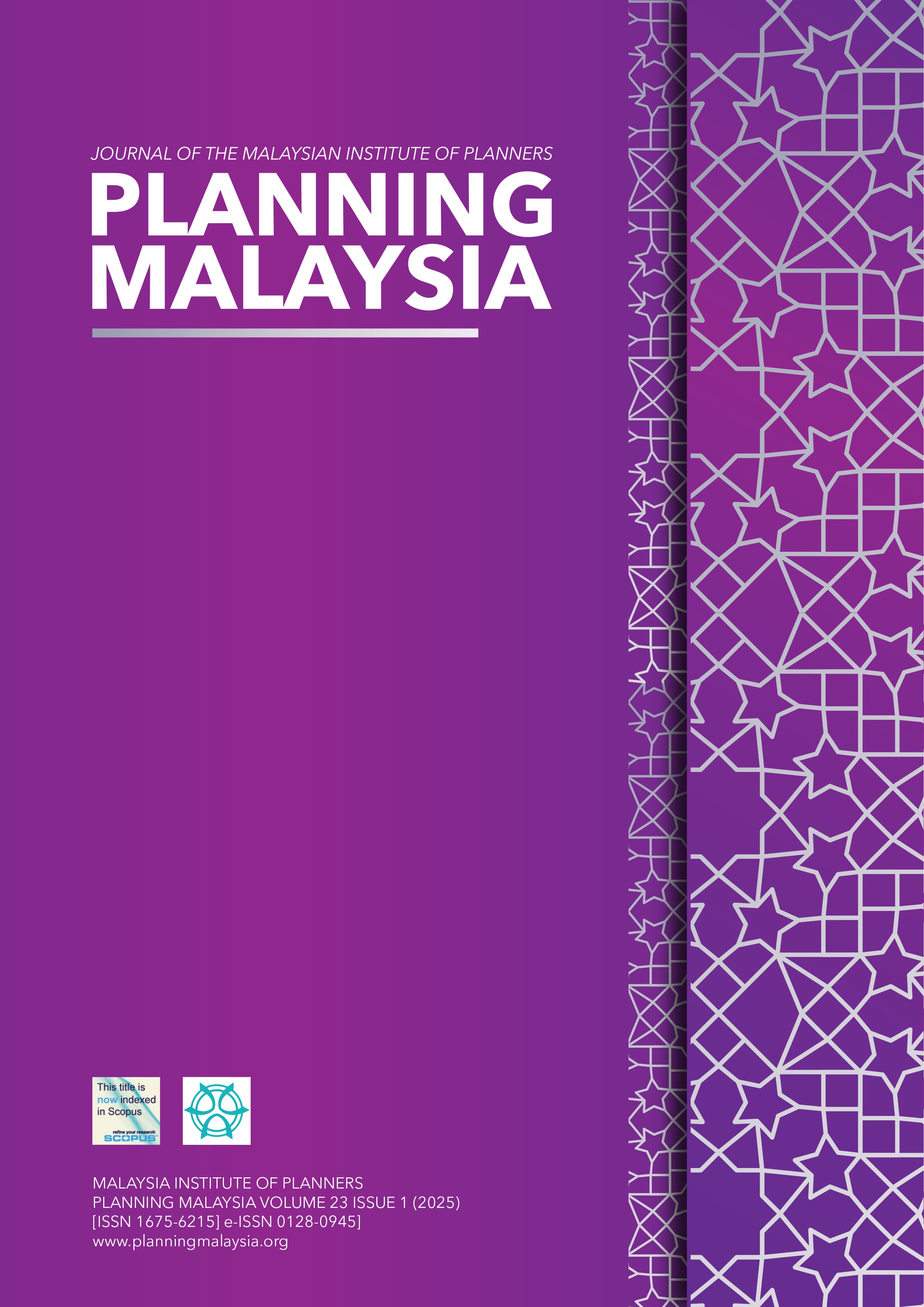PLANNING FOR COMMUNITY ADAPTATION TO THE RISK OF FOREIGN SHIP TRAFFIC ON INTERNATIONAL SHIPPING LANES IN THE INDONESIAN ARCHIPELAGO SEA ROUTE
DOI:
https://doi.org/10.21837/pm.v23i35.1667Keywords:
Indonesian Archipelago Sea Route, Ship Emissions, Carbon Management, Nationally Determined Contribution, Net Zero EmissionAbstract
The International Convention Law on the Sea, which was adopted by the United Nations in 1982, granted foreign-flagged ships the right to pass safely and smoothly through the Indonesian Archipelago Sea Route/Alur Laur Kepulauan Indonesia (ALKI). The density of the shipping lanes has triggered risks such as accidents and environmental pollution caused by ship exhaust carbon emissions. Therefore, this qualitative research aimed to determine the possibilities of coastal communities to adapt to the risk in accordance with the policy of ship traffic regulation with international shipping lanes through the Traffic Separation Scheme. There is still limited research on the community’s adaptation due to ship exhaust carbon emissions and the lack of adaptation actions taken in response to environmental pollution from foreign ship exhaust emissions. Adaptation efforts recommended include the preparation of collaborative measures and strategies to ensure the carbon management has a net zero emission value on foreign ship traffic in ALKI. The result showed that adaptation effort can be used to ensure Indonesians Nationally Determined Contribution (NDC) can prevent global temperature rise from the shipping sector through carbon management, decarbonization, and energy transition programs.
Downloads
References
Alamsyah, A. T., & Sikumbang, I. H. (2023). Negara Arsipelago Indonesia 2045: 100 Tahun Memadukan Laut Dan Pulau Sebagai Pemersatu Jati Diri Bangsa. Lembaga Kajian Peminatan Sejarah (LKPS).
Adger, W. N., & Vincent, K. (2005). Uncertainty in adaptive capacity. Comptes Rendus Géoscience, 337(4), 399–410. https://doi.org/10.1016/j.crte.2004.11.004 DOI: https://doi.org/10.1016/j.crte.2004.11.004
Aisyah, R., Nur, Majid, & Jamaluddin, Suhartono. (2020). Carbon tax: An alternative policy to reduce external diseconomies of carbon emissions. ISAFIR Journal Publication, Alauddin State Islamic University, Makassar.
Bakti, L. A., & Sukartono. (2022). Collaboration as a strategy for community adaptation in small islands to climate change. Publication of the Indonesian Fisheries Service Journal, Mataram University.
Budiyanto, M. A., Adha, A., & Prayoga, P. H. N. Distribution of energy efficiency design index for tankers in Indonesia. The 5th International Conference on Renewable Energy and Environment Engineering. France.
Geospatial Information Agency. (2023). The official number of islands in Indonesia. Accessed on 1 April 2024: https://www.cnnindonesia.com/teknologi/20230619171810-199-963898/jumlah-pulau-resmi-di-ri-capai-17024-masih-ada-yang-tanpa-identitas
Chatzinikolaou, S. D., & Ventikos, N. P. (2015b). Holistic framework for studying ship air emissions in a life cycle perspective. Ocean Engineering, 110, 113–122. DOI: https://doi.org/10.1016/j.oceaneng.2015.05.042
Cosco Shipping Heavy Industry. (2023). New building technology for ultramax dry bulk ship. Shanghai.
Denzin, N. K. (2009). The research act: A theoretical introduction to sociological methods (1st ed.). Routledge. https://doi.org/10.4324/9781315134543 DOI: https://doi.org/10.4324/9781315134543
European Commissions. (2022). JRC technical report: Quantifying emissions in the European maritime sector. Joint Research Center, Luxembourg.
Hadi, I. (2023). Community adaptation to ship exhaust carbon emissions pollution in Semayang Harbor. University of Indonesia, Jakarta.
Hidayat, A. S., Soemantri, A. S., & Poernomo, H. (2019). Implementation of the Indonesian Archipelago Sea Route (ALKI) II control strategy in supporting national resilience. Journal of National Resilience, Gadjah Mada University.
Hutagalung, S. M. (2019). Determination of the Indonesian Archipelago Sea Route: Benefits and threats to shipping security in Indonesian waters.
Indonesian Cabotage Advocation Forum (INCAFO). (2014). Sewindu memerah putihkan biru lautan Indonesia. Jakarta: ILUNI FTUI.
Indonesian National Shipowners Association (INSA). (2023). Annual report: Readiness of the national shipping industry towards advanced Indonesia and golden Indonesia 2045. Jakarta.
Institute of Environmental Management and Assessment. (2020). Carbon and GHG management hierarchy. Fenland House, Cambridgeshire, PE15 OAX.
Intergovernmental Panel on Climate Change (IPCC). (2007). IPCC guidance for national greenhouse inventories. IPCC Reference Manual.
International Maritime Organization (IMO). (2020). Adoption of the initial IMO strategy on reduction of GHG emissions from ships and existing IMO activities related to reducing GHG emissions in the shipping sector. UN IMO.
Lembang, R. K., & Iwamony, S. (2012). Study of urban forest needs as a CO2 sink in Tabelo City in 2012. Directorate General of Climate Change Control, Ministry of Environment of the Republic of Indonesia, Jakarta.
Listiyono, Y., Prakoso, L. M., & Sianturi, D. (2022). Sea defense strategy in securing the Indonesian Archipelago Sea Route to achieve maritime security and maintain Indonesian sovereignty. University of Defense, Jakarta. DOI: https://doi.org/10.37500/IJESSR.2021.4313
Martins, M. D. A. P., Huboyo, H. S., & Samadikun, B. P. (2022). Emisi polutan konvensional dari aktivitas di alur pelayaran pelabuhan Dili. Jurnal Serambi Engineering, 7(3). https://doi.org/10.32672/jse.v7i3.4268 DOI: https://doi.org/10.32672/jse.v7i3.4268
Marine Environment Protection Committee (MEPC). (2023). 80th session. IMO.
Marine Traffic. (2022). Global ship tracking intelligence.
Nahlik, M. J., Kaehr, A. T., Chester, M. V., Horvath, A., & Taptich, M. N. (2015). Goods movement life cycle assessment for greenhouse gas reduction goals. Journal of Industrial Ecology, 20(2), 317–328. DOI: https://doi.org/10.1111/jiec.12277
Nevers, N. D. (2000). Air pollution control engineering (2nd ed.). McGraw-Hill International Edition, Utah.
Presidential Regulation of the Republic of Indonesia Number 98 of 2021 concerning the implementation of carbon economic value for achieving nationally determined contribution targets and controlling greenhouse gas emissions in national development.
Downloads
Published
How to Cite
Issue
Section
License

This work is licensed under a Creative Commons Attribution-NonCommercial-NoDerivatives 3.0 Unported License.
Copyright & Creative Commons Licence
eISSN: 0128-0945 © Year. The Authors. Published for Malaysia Institute of Planners. This is an open-access article under the CC BY-NC-ND license.
The authors hold the copyright without restrictions and also retain publishing rights without restrictions.


